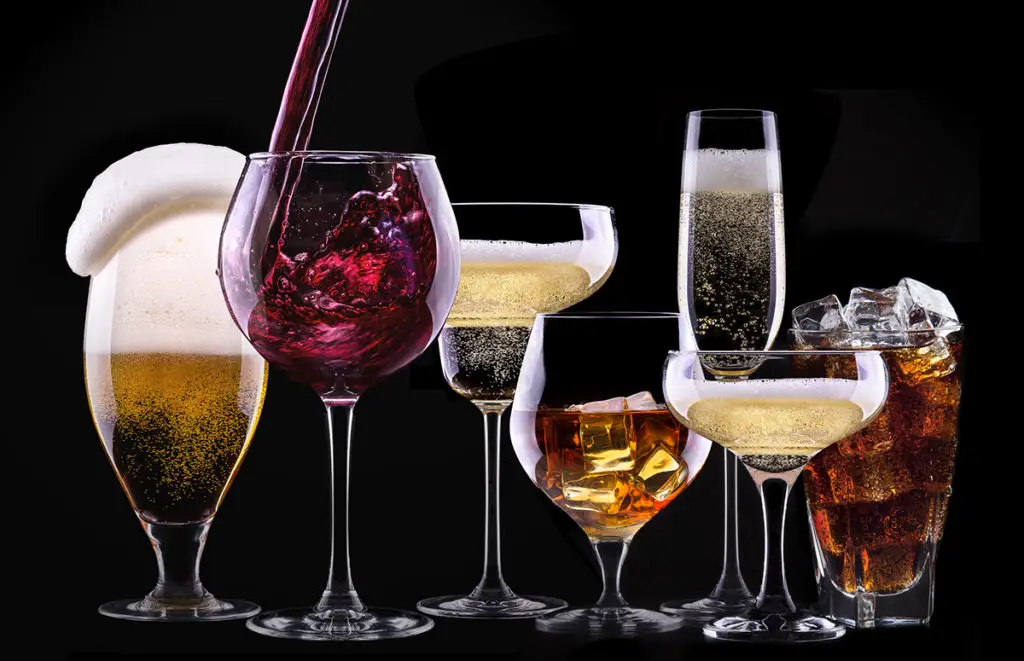The pH of a compound is useful to know for many reasons, like health and the environment. It’s common to analyze water’s pH, but you can also measure the pH of other liquids like alcohol. So what is the pH of alcohol?
Pure alcohol, also known as ethanol, has a pH of 7.33, making it slightly basic. But as alcohol ferments into drinks like beer, wine, and liquor, its pH changes. Usually, fermented alcohol becomes more acidic, with a pH level between 2 and 5, but there are a few slightly basic alcohols too.
This article explains what pH is, what the pH of alcohol is, and some examples of how the pH of alcohol differs. I will also look at the pH level of other liquids to see how they compare to water.
What Is pH?
The pH of a liquid measures how acidic or basic it is. Scientists measure pH on a scale from 0 to 14, with 0 being the most acidic and 14 being the least acidic and most basic. A pH of 7 indicates that the substance is neutral.
Each number on the pH scale represents a ten-time difference in acidity or basicity. So something with a pH of 3 is ten times more acidic than something with a pH of 4.

BEER DROP: Boxes of beer from Award-winning microbreweries → Join The Club
On a more scientific level, pH measures how much hydrogen and hydroxyl ions are in a liquid. Something acidic has more hydrogen ions, and something more basic has more hydroxyl ions.
Anything with a pH of 7 is as pure as a liquid can be, with no acidity and no basicity. Water has a pH of 7, which makes it completely neutral. It has no acidity and basicity.
But, other types of water can be more acidic or basic. For example, acid rain has a low pH closer to 1 instead of the pH level of 7 for pure water. And rainwater has a pH of approximately 5.6. Another type of water that is basic instead of acidic is seawater which has a pH of 8. A more basic, less acidic water allows sea animals to survive.
You can test the pH level of water, but it works for other liquids like alcohol, soda, and cleaners, too, as I will explain throughout the article. Knowing the pH level of something is important to determine how healthy it is for your body and the environment.
Measuring pH Levels of Liquids
Testing the pH level of something is quite easy, and there are a few ways to do so.
If you want to test the pH level of something, there are a few items you can use. Most common is an electronic pH meter, which is easiest but is not a common item to have. To do pH tests at home, you can use litmus paper, which is cheaper and more convenient, although also less accurate.
Here is a YouTube video from Carly Reeder that shows pH tests being performed on a couple of different beverages like coffee, soda, alcohol, and water:
If you want to do a pH test at home, try out these two products from Amazon:
- PH Meter for Water Hydroponics. This small pH meter is easy to use and store at home and great for measuring the pH level of various household items like pool water, drinks, and aquariums. It also comes in three colors, red, blue, and yellow, if you want to buy multiple for different uses.
- Plastic pH Test Strips. This one hundred pack of pH strips gives you fast results using a provided color chart. You can test a large variety of things with these strips, including saliva, soap, urine, food, liquids, water, and soil.
The pH of Alcohol
The pH of pure alcohol, or ethanol, is 7.33, which means it’s a little basic. Pure alcohol is a straight-chain compound, and the symbol is C2H5OH.
However, not all alcohol is basic. As ethanol ferments into different, more common alcoholic beverages, the pH changes. To be considered alcoholic after it’s fermented, a beverage must have more than 2.8% ethanol.
Usually, fermenting ethanol makes it more acidic, but there are a few exceptions. In the next section, I’ll share the results from a scientific experiment done to determine the pH of some popular alcoholic beverages. Not to spoil the results, but only one of the alcoholic beverages had a pH over 7, making it basic. All the other alcoholic beverages had acidic pHs under 7.
The pH of Alcohol Study and Examples
The pH of alcohol varies as it’s fermented and is no longer pure alcohol. Professors and researchers at three dental universities in Brazil did an experiment to determine the pH of thirteen different alcoholic beverages, and we have detailed and explained their findings.
Alcoholic Beverages in the pH Study
First, they used a variety of alcoholic beverages in the study. These beverages covered multiple types of alcohol, including beer, sugarcane liquor, alcopops, red wine, and whisky.
Here are the thirteen specific beverages used in the experiment and their pHs as determined by the study.
- Skol Beer: pH of 4.05 (Acidic)
- Skol Beats Beer: pH of 2.51 (Acidic)
- Brahma Beer: pH of 4.11 (Acidic)
- Antarctica Beer: pH of 3.85 (Acidic)
- Heineken Beer: pH of 4.26 (Acidic)
- Pitu Liquor: pH of 4.29 (Acidic)
- 51 Liquor: pH of 4.01 (Acidic)
- Smirnoff Red Triple Alcopop: pH of 7.64 (Basic)
- Smirnoff Ice Alcopop: pH of 2.70 (Acidic)
- Miks Ice Tea (Green Fruits) Alcopop: pH of 2.49 (Acidic)
- Miks Ice Tea (Green Apple) Alcopop: pH of 2.71 (Acidic)
- Quinta do Morgado Red Wine: pH of 3.12 (Acidic)
- Teacher’s Whiskey: pH of 3.80 (Acidic)
They also found the pH of coca-cola and mineral water as controls in the study. Here were their findings for the control subjects:
- Ibira Mineral Water: pH of 10.11 (Basic)
- Coca-Cola Soda: pH of 2.47 (Acidic)
Coke actually has a pH ranging from 2.6 to 2.7, so the study was not exactly accurate in determining its pH. It was off by a couple of tenths, so it was close, and it was still showing the soda as acidic.
The mineral water has an actual pH of 10.24, so the study was also a few tenths off in determining the pH of the mineral water. But, again, it still showed Ibira as being basic.

Alcohol pH Study Conclusion
So, as you can see, the two control beverages were slightly off in this study, so the pHs of the thirteen alcoholic beverages studied were likely not completely accurate either. But, if they are off by a few tenths of a pH level, we still have a good idea of what their pH level is and how acidic, or in one case, slightly basic, they are.
I can conclude that the pHs of the alcohol types found in this study are also quite accurate but may be off by a few tenths of a pH value. All the alcohols in this study, except for one, had a pH between 2 and 5, so they are acidic. They’re also acidic compared to pure alcohol, which is slightly basic.
The one basic alcohol in the study, the Smirnoff Red Triple Alcopop, which had a pH of 7.64, barely changed as far as pH goes. It only changed by 0.31 compared to ethanol.
pH Comparison
Now that we know the pH of alcohol and how it varies as alcohol ferments, let’s look at how other common drinks and liquids compare in their pH levels.
We can compare the pH of alcohol to the pH of other common liquids using a publication from the US government’s EPA.
First, let’s look at how they mark the pH of a few liquids we saw in the study above. Beer has a pH level of 4, and Coke has a pH of 2.5. These pH values are quite similar to the findings in the study.
The most acidic item is battery acid which has a pH level very close to zero. A close second is stomach acid, or hydrochloric, which has a pH of 1.
Here are a few other common acidic liquids and their pH levels:
- Vinegar: pH Level of 2
- Orange juice: pH Level of 3
- Black coffee: pH Level of 5
- Urine: pH Level of 6
- Saliva: pH Level of 6
- Milk: pH Level of 6
Now, let’s go to the opposite side of the pH scale and look at basic substances. The most basic liquid is liquid drain cleaner, which has a pH level closest to 14, the highest number on the pH scale. Bleach is also very basic, with a pH level of 13.
Here are a few other common basic liquids and their pH levels:
- Eggs: pH Level of 8
- Baking soda: pH Level of 8
- Toothpaste: pH Level of 9
- Handsoap: pH Level of 9
- Detergent: pH Level of 10
- Soapy water: pH Level of 11.5
Final Thoughts
The pH level of ethanol, or pure alcohol, is a basic 7.33. But, as alcohol ferments, it almost always becomes more acidic because of the sugars and yeast used in the fermentation process.
If an alcohol’s pH level doesn’t turn acidic but stays basic, it won’t change by much and stay close to pure alcohol’s slightly basic pH level. You can use test strips, a pH level pen, or an electronic meter to easily and quickly find the pH level of anything from your home.
